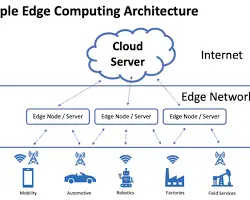Back-End & Web Development Trends for 2024: Navigating the Digital Frontier
The digital landscape is ever-evolving, and staying ahead of the curve as a back-end or web developer requires constant learning and adaptation. As we delve into 2024, several prominent trends are shaping the future of back-end and web development, offering exciting opportunities and challenges alike.
1. Serverless Architecture Takes Center Stage:
Move over, traditional servers! Serverless architecture is rapidly gaining traction, removing the burden of server management and allowing developers to focus on code. By leveraging cloud functions and services, developers can build and deploy scalable, cost-efficient applications without worrying about infrastructure. Imagine the freedom of focusing solely on creating elegant code without server headaches!


2. Microservices for Agility and Resilience:
The monolithic application is becoming a relic of the past. Microservices architecture, where an application is composed of independent, loosely coupled services, is taking center stage. This approach fosters agility, resilience, and faster development cycles, making it ideal for complex, ever-changing applications. Think of it as building with Lego blocks, each service independently developed and connected for seamless functionality.

3. The Rise of Edge Computing:
Data latency is becoming a relic of the past thanks to edge computing. By processing data closer to the source, at the network edge, developers can create faster, more responsive applications, particularly for real-time experiences like IoT and online gaming. Imagine users in New Zealand enjoying lag-free online games hosted in Europe, thanks to edge computing processing power closer to them.


4. AI and Machine Learning Integration:
The lines between back-end development and AI are blurring. Integrating AI and machine learning into applications is becoming increasingly common, enabling features like personalized recommendations, anomaly detection, and automated decision-making. This trend opens doors for creating intelligent and adaptive web experiences that learn and improve over time.


5. GraphQL for Efficient Data Queries:
REST APIs have served us well, but GraphQL is offering a compelling alternative. This query language allows for requesting specific data fields, reducing unnecessary data transfer and improving performance. Think of it as ordering a la carte instead of the whole buffet, getting only the data you need for a leaner and faster experience.


6. Security Takes Top Priority:
With cyber threats on the rise, security is paramount. Back-end and web developers must prioritize robust security measures, including secure coding practices, data encryption, and regular vulnerability assessments. Protecting user data and ensuring application integrity is more crucial than ever in today’s digital world.


7. Focus on Accessibility and Inclusivity:
The web should be for everyone, and developers have a responsibility to create accessible experiences. This means incorporating features like screen reader compatibility, keyboard navigation, and clear labeling to ensure all users can interact with websites and applications. Let’s build a web that embraces diversity and empowers everyone to participate.


8. Low-Code/No-Code Development Democratizes Creation:
Coding isn’t for everyone, but that shouldn’t limit creativity. Low-code/no-code platforms are empowering individuals with limited coding experience to build simple applications and websites. This trend democratizes development, enabling anyone to bring their ideas to life without writing complex code.


9. Progressive Web Apps (PWAs) Bridge the Gap:
The line between native apps and web experiences is blurring with PWAs. These web apps offer features like offline functionality, push notifications, and home screen installation, providing a native-like experience without the need for app stores. Think of it as having the best of both worlds, the reach of the web and the feel of a native app.


10. The Great Developer Talent Hunt:
The demand for skilled back-end and web developers is booming. As these trends continue to evolve, developers who stay ahead of the curve and embrace new technologies will be highly sought-after. Continuous learning and upskilling are key to thriving in this dynamic landscape.

These are just a glimpse into the exciting future of back-end and web development. By embracing these trends and staying adaptable, developers can create innovative and impactful experiences that shape the digital world of tomorrow. Remember, the journey is just as important as the destination, so keep learning, experimenting, and pushing the boundaries of what’s possible!
